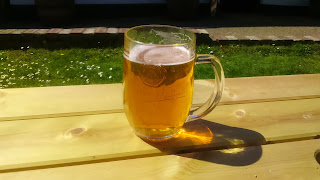 It was a disappointing turnout for last Thursday night’s CAMRA social, with just three of us making the trip over to the village of Rusthall, near Tunbridge Wells, for a visit to the recently refurbished Toad Rock Retreat. Later on we were joined by two other members, one of whom lives locally; but it was still a poor show for a branch which can boast over 500 members! However, the bulk of West Kent CAMRA members who, for whatever reason, couldn’t be bothered to turn out missed a really good evening, in a nice pub whose appeal is added to by its unique setting.
It was a disappointing turnout for last Thursday night’s CAMRA social, with just three of us making the trip over to the village of Rusthall, near Tunbridge Wells, for a visit to the recently refurbished Toad Rock Retreat. Later on we were joined by two other members, one of whom lives locally; but it was still a poor show for a branch which can boast over 500 members! However, the bulk of West Kent CAMRA members who, for whatever reason, couldn’t be bothered to turn out missed a really good evening, in a nice pub whose appeal is added to by its unique setting. Rusthall is located approximately 2 miles to the west of Tunbridge Wells, in what is really a continuation of Tunbridge Wells Common. Much of the village is hidden among trees and is surrounded by some quite impressive sandstone outcrops. The latter became quite a tourist attraction in Victorian times, when visitors were brought up from the station in coaches or “charabancs” to see the rocky outcrops.
The most famous of these outcrops is the “Toad Rock”, a natural rock formation which looks like a sitting toad, resting on an outcrop of sandstone, and what makes the “Toad Rock” appear even more impressive is its setting in the natural amphitheatre created by the surrounding rocks. The rock formation is not man-made, but was eroded into its current shape by action of both wind and frost during the last Ice Age. The first known record of the rock's name is in a guide published in 1823; although the rock itself was first popularised in a local guide published a decade earlier. The fencing around the rock's base was first installed in 1882 and was renovated in 1993-94.
 |
| The Toad Rock |
The Toad Rock Retreat was refurbished at the beginning of 2016, and has taken on a new lease of life under the stewardship of experienced licensees, Nick and Shelley, who were previously in charge of the Dovecote at Capel. I am unsure as to the age of the pub, as it was completely rebuilt, after being destroyed by a disastrous fire in 1998, but it is an attractive-looking building, nevertheless.
The pub was re-constructed in a style which matched the original, and consists of a brick structure, which is part tile-hung. Internally there is a double open-sided wood burning fireplace which separates the spacious main bar area, from a peaceful snug section containing comfy leather seating set around the fireside. There is a dining area to the left, which includes cosy tables lit by fairy lights intertwined around internal branches attached to the walls.
 |
| Local scenery |
We spent around two and a half hours at the Toad Rock Retreat, chatting and enjoying the beer. The pub had been quite busy when we arrived, but towards the end of our stay, people (mainly diners), began to drift off. The food on offer looked good, which is no surprise as Nick and Shelley were well-known for providing good fayre at the Dovecote. Nick was genuinely pleased to see us, but it was a shame there were so few in our party. Still, the couple are happy with the way the pub is developing; as are I’m sure the locals, after the period of uncertainty under its previous tenants.
 |
| A few of the beers available at the Bedford |
Footnote: There is another part to Rusthall which is distinct from the Victorian era tourist resort created around Toad Rock. The other section lies to the north-west, and is set around Lower Green; the oldest part of the village and said to date from around the 8th century. There are many attractive walks across Rusthall Common, towards either Speldhurst or Southborough; both walks completely avoiding the built-up areas of Tunbridge Wells.
It is quite easy to get lost around here though; even with the aid of a good map, as my friend Eric and I found out when we were walking the Weald Way, six years ago.
























